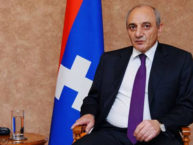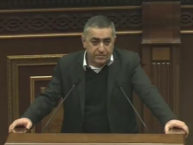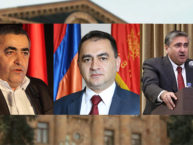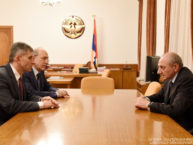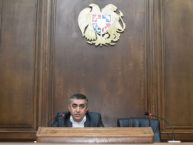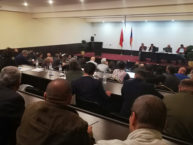On September 7, several opposition parties in Armenia, including the Armenian Revolutionary Federation-Dashnaktsutyun, issued an announcement declaring National Democratic Union leader Vazgen Manoukyan the sole candidate representing the national alliance accord.
National Self-Determination Union candidate Paruyr Hairikyan, Democratic Party of Armenia candidate Aram Sargsyan and “Artsakh-Hayastan” candidate Lenser Aghalovyan all withdrew their candidacies from the September 22 presidential elections and rallied around Manoukyan as their choice for a president.
| The closing of the NDU, the National Self-Determination Union, the Union of Constitutional Rights, and Artsakh-Hayastan, if permanent, would deal a severe blow to freedom of association in Armenia, (protected under article 22 of the ICCPR), particularly in view of the 1994-95 proceedings against the ARF. Letter to Armenian President Levon Ter-Petrossian from Holly Cartner, Executive Director Human Rights Watch/Helsinki, October 1, 1996 |
The accord, which stemmed from on-going opposition talks, also put forth a platform calling for the creation of a coalition government, elections for a new National Assembly, as well as a new constitution which would be ratified within two years.
On Sunday, September 22, as results began to trickle in from the presidential elections, incumbent President Levon Ter-Petrossian trailed opposition alliance candidate Vazgen Manoukyan of the National Democratic Union.
On Monday, September 23, while President Levon Ter-Petrossian declared himself the winner, Manoukyan accused Ter-Petrossian of trying to steal the election. The contest between the two former close allies, both of whom played big roles in leading Armenia to independence from the Soviet Union in 1991, had grown bitter.
Manoukyan and his supporters alleged massive fraud, voter intimidation, and other irregularities were being committed by Ter-Petrossian’s forces. Through mass rallies, they demanded from the Central Electoral Commission to recount the votes.
The Organization for Security and Cooperation in Europe, which had been coordinating 89 international observers, issued a preliminary report criticizing “very serious” irregularities in voting procedures.
On September 25, a couple thousand of the 150 thousand protesters stormed the National Assembly compound. Riot police fired from inside the building. Police who stood waiting outside while the crowd chanted slogans, marched toward the demonstrators, firing shots over their heads.
Meanwhile, a delegation comprised of Manoukyan and Armenian Revolutionary Federation Supreme Council member Ruben Hakobyan had entered the parliament building for negotiations with CEC officials.
Following the scuffle, the whereabouts of delegation members, Hakobyan, Vova Hakhverdyan and Seyran Avagyan – all National Assembly deputies – who were accompanying Manoukyan at the CEC talks and stayed behind while Manoukyan addressed protesters, were unknown.
| The four weeks preceding the 1996 Armenian presidential election constitute a classic example of how a marked disbalance in resources between state-controlled and still relatively weak independent media can translate into a crucial advantage and tactical weapon to a national leadership faced with an unexpected and rapidly evolving political challenge – in this instance the consolidation of disparate political forces in support of opposition presidential candidate Vazgen Manukyan. The general situation of the non state controlled media in Armenia has improved over the The European Institute for the Media / Yerevan Press Club Media Monitoring of the Armenian Presidential Election 24 September, 1996 |
Armenia’s Interior Minister Vano Siradeghyan, Defense Minister Vazgen Sargsyan and National Security Minister Serge Sargsyan made televised speeches, characterizing the day’s events as a coup attempt and asserting that those responsible – referring to Manoukyan and other opposition leaders – would be punished. Defence Minister Vazgen Sargsyan said there was no chance that Manoukyan could ever have taken power.
“Even if he got 100 percent of the vote, neither the army nor the interior ministry nor the security forces would accept him,” he said.
Ter-Petrossian appeared on national TV and called the demonstration by thousands of unarmed Manoukyan supporters in which some of them stormed the parliament building and beat up the speaker as a “fascist” coup by “mentally ill people.”
Armenian President Levon Ter-Petrossian is using recent unrest to imprison political opponents and stifle dissent, diplomats based in Yerevan said, reported “Reuters” on September 30.
Diplomats and opposition politicians say that up to 250 people have been detained since the unrest, some of whom had nothing to do with the protest. Others have gone into hiding.
“We are talking about a very substantial number of people who have been put in prison,” said one Western diplomat. “We are extremely concerned about this and we will be asking the government for an explanation.”
Many diplomats said it appeared that the government had let the protest get out of control to be able to clamp down and avoid opposition calls for a recount.
At least three opposition parties, including Manoukyan’s National Democratic Union, the National Self-Determination Union and the smaller Constitutional Rights Union have been closed down and their offices are now guarded by government security forces.
Parliamentary deputy Aramazd Zakaryan, a former NSDU member, said from a hospital bed that he had been beaten and had spent two days in detention.
Zakaryan, who has a fractured skull, a broken rib and facial lacerations, said he was beaten again at a police holding center. He was released after two days and relatives brought him to the hospital.
Leading opposition figures who have not been arrested say the unrest was a convenient excuse for Ter-Petrossian to wipe out dissent.
Diplomats dismissed the idea that the protests, in which 59 people were hurt, were an attempt to topple the government. “I don’t know if he (Ter-Petrossian) actually believes this, but I can say that almost no one else does,” said one, who did not wish to be identified.
“This whole thing was nicely stage-managed and now Ter- Petrossian doesn’t have to deal with elections or an opposition,” he said.
Diplomats and opposition sources say up to 250 people have been detained on political grounds and some have been beaten up, although the prosecutor’s office says it knows nothing about large-scale arrests. With parliament dominated by his ruling bloc Ter-Petrossian runs a virtual one-party state.
ARF NEWS
August-September 1996
Volume 1.5(5)


